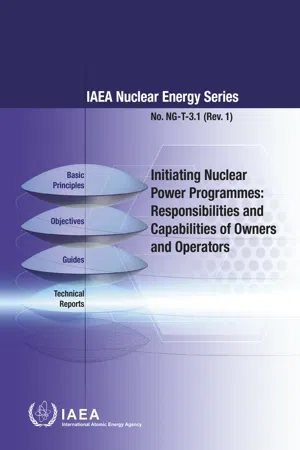1. INTRODUCTION
1.1. Background
The introduction of nuclear power in a country requires the development of the institutional, human and physical infrastructure that will support the nuclear power programme throughout its life cycle. A number of organizations will be involved in the programme, each with particular responsibilities and capabilities. The IAEA publication Milestones in the Development of a National Infrastructure for Nuclear Power [1] (hereafter ‘the Milestones approach’) describes the role of the three key organizations:
— The government;
— The regulatory body;
— The owner/operator of the nuclear power plant.
The Milestones approach [1] has been widely adopted by countries embarking on a new nuclear power programme as well as by countries expanding their existing programmes after a long period without new constructions. It describes a set of infrastructure issues to be addressed during three distinct phases in the development of the infrastructure for a nuclear power programme, each punctuated by a milestone (see Fig. 1).
The three phases are [1]:
— Phase 1: Considerations before a decision to launch a nuclear power programme is taken.
— Phase 2: Preparatory work for the contracting and construction of a nuclear power plant after a policy decision has been taken.
— Phase 3: Activities to implement the first nuclear power plant.
The three milestones are [1]:
— Milestone 1 (at the end of Phase 1): Ready to make a knowledgeable commitment to a nuclear power programme.
— Milestone 2 (at the end of Phase 2): Ready to invite bids/negotiate a contract for the first nuclear power plant.
— Milestone 3 (at the end of Phase 3): Ready to commission and operate the first nuclear power plant.
Each organization has a specific role to play, with responsibilities that change as the programme advances. The NEPIO is responsible for the overall coordination of the programme and ensures the engagement of all important parties. The regulatory body is responsible to make independent regulatory decisions that are free from any undue influences, such as pressures associated with changing political circumstances or economic conditions. The owner/operator is responsible for selecting the technology, preparing and assessing the bid (if using competitive bidding), negotiating the contract(s) and managing the nuclear power plant project, including applying for the licences required for construction and operation.
This publication assumes that the same organization will own and operate the nuclear power plant, hence the term ‘owner/operator’. The less frequent case where the owner and the operator are separate entities is discussed in Section 3.3. Similarly, this publication assumes that the owner/operator will procure a plant through an engineering–procurement–construction (EPC) contract, also called a turnkey contract (see Section 3.2 for a description of the impact of other contracting approaches).
1.2. Objective
This publication provides guidance on the main activities to be undertaken by the owner/operator during Phases 2 and 3 of nuclear power infrastructure development. Member States can use this information to ensure that the responsibilities and capabilities of the owner/operator are understood by all nuclear power programme stakeholders and that the owner/operator develops effectively in line with the project schedule.
1.3. Scope
This publication describes the responsibilities and capabilities of the owner/operator during Phases 2 and 3 of nuclear power infrastructure development and provides guidance on developing the required competencies for the organization. It also discusses the management of the interfaces between the owner/operator and other stakeholders. It does not explicitly address Phase 1, as it is assumed that the owner/operator is designated early in Phase 2. Guidance provided here, describing good practice, represents expert opinion but does not constitute recommendations made on the basis of a consensus of Member States.
1.4. Structure
The structure of this publication comprises six sections, including this introduction. Section 2 lists the desired attributes that an owner/operator should develop over the course of the programme. Section 3 describes typical organizational structures for an owner/operator organization following a variety of contracting approaches. Section 4 outlines the main responsibilities of the owner/operator in Phases 2 and 3. Section 5 describes the evolving nature of the owner/operator during the implementation of the programme and suggests some approaches to develop competence. Section 6 describes the interfaces that the owner/operator needs to manage with its main stakeholders.
1.5. Users
This publication is intended to be used by decision makers, owner/operator executives and staff as well as others in organizations involved in the nuclear power programme. It may also be useful to countries expanding their nuclear power programmes after long periods without new projects.
2. DESIRED ATTRIBUTES OF AN OWNER/OPERATOR
The owner/operator is expected to perform key activities during Phases 2 and...

